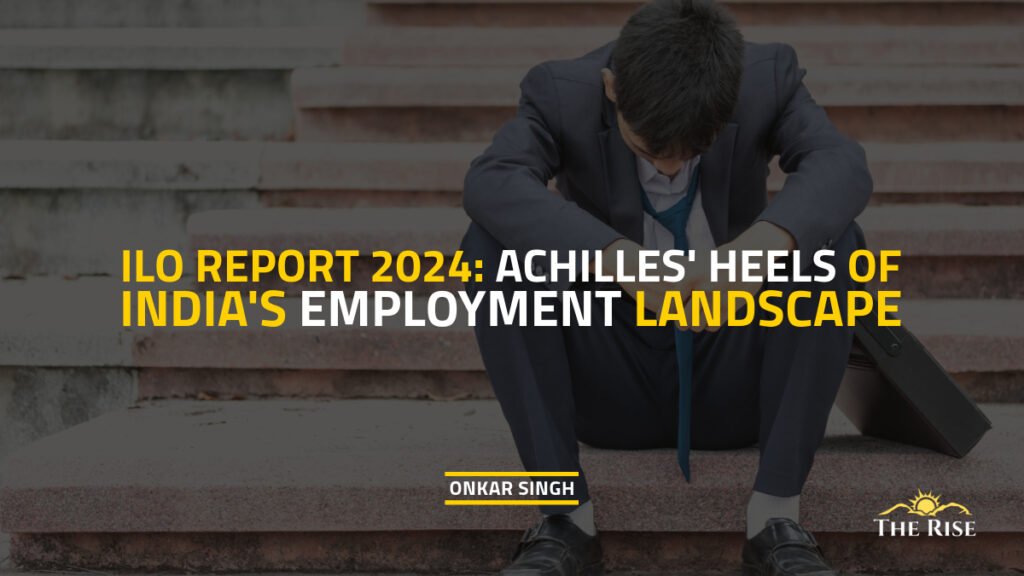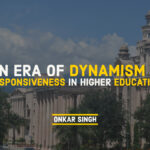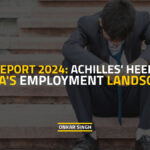The precarious situation of unemployment as underlined by the recently released India Employment Report 2024 by ILO necessitates contemplation for overall improvement in the education system by strengthening its core of teaching-learning, strengthening the ecosystem for self-employment, safeguarding the casual employment workers and incentivising clusters of manufacturing at micro/medium/small enterprises level.
The recent India Employment Report 2024 brought out by the International Labour Organization (ILO) indicates the decline in labour force participation rate (LFPR) among youths from 54 per cent in 2000 to 42 per cent in 2022, and the decline is sharper among youths aged 15–19 compared to youths aged 20–24 and 25–29. The LFPR quantifies the proportion of the country’s population actively engaged in the labour market either by working or seeking work in the form of employment which could be self-employment, regular employment and casual employment. LFPR in India for individuals aged 15 years and older was 55.2 per cent in 2022, which was lower than the world average of 59.8 per cent.
The ILO report indicates that in 2022, self-employment accounted for 55.8 per cent of employment while casual and regular employment accounted for 22.7 per cent and 21.5 per cent, respectively. The share of self-employment remained almost stable, at around 52 per cent between 2000 and 2019, and regular employment consistently and considerably increased, by nearly 10 percentage points, from 14.2 per cent to 23.8 per cent. But these trends reversed by 2022, with an increase in the share of self-employment by 3.8 percentage points, to 55.8 per cent, while the share of regular employment declined by 2.3 percentage points, to 21.5 per cent. The share of casual employment consistently declined, from 33.3 per cent in 2000 to 22.7 per cent in 2022. This increase in the share of self-employment and decline in regular employment can be attributed to either the reduction in regular employment opportunities or enhancement in entrepreneurial initiatives leading to an increment in self-employment.
Also Read: Breaking Silence on Silent Sufferings
Figure 1 shows how the average monthly real earnings of regular, casual and self-employed persons changed in the last decade. The average earnings of casual workers increased slightly, pointing to poor-quality employment generation. The average monthly earnings for regularly employed persons declined annually by 1.2 per cent, from 12,100 rupees in 2012 to 11,155 rupees in 2019, and by 0.7 per cent as of 2022, to 10,925 rupees. The average earnings of self-employed individuals declined annually by 0.8 per cent, from 7,017 rupees in 2019 to 6,843 rupees in 2022. The average monthly earnings of casual workers increased by 2.4 per cent annually, from 3,701 rupees in 2012 to 4,364 rupees in 2019, and by 2.6 per cent annually, to 4,712 rupees in 2022 which is good for the economy. The declining earnings of regular workers and self-employed workers indicate concerns about the employment generation between 2000 and 2022.

Figure 1 Average monthly earnings of regular, casual and self-employed workers, 2012, 2019 and 2022 (Rupees, at 2012 prices) [Source: https://www.ilo.org/wcmsp5/groups/public/—asia/—ro-bangkok/—sro-new_delhi/documents/publication/wcms_921154.pdf]
Further, the ILO report says that educated youths have experienced much higher levels of unemployment and the youth unemployment rate has increased with the level of education and the highest rates are among those with a graduate degree or higher and higher among women than men. In 2022, the unemployment rate among youths was six times greater than among persons with a secondary or higher level of education (at 18.4 per cent) and nine times greater among graduates (at 29.1 per cent) than for persons who cannot read and write (at 3.4 per cent). Educated female youths experienced higher levels of unemployment compared with educated male youths.
Also Read: Beyond Books and Bells: Organizational Citizenship Behavior in Higher Education
The contents of the ILO report are corroborated by the extremely large number of candidates appearing in the most prestigious and rigorous Civil Services Examination (CSE) conducted annually by the Union Public Service Commission. The recently declared results of CSE-2023 selected 1016 out of around 13 lakh applicants as compared to 933 selected for appointment out of 11356797 applicants in CSE-2022, 761 selected out of 1093948 applicants in CSE-2021, and 833 selected out of 1040060 applicants in CSE 2020.
Also Read: Exploring the Intersection of AI, Web Data Scraping, and Copyright: Legal and Ethical Considerations
These statistics show a broader picture of the inadequacy of employment opportunities, variation in different types of engagements of human resources for their survival, absence of coherence between education and employment, and differential treatment of males and females in employment. Also, it is seen from the result that a good number of candidates are those who have worked in private companies and left them to join the Civil Services of the country. There could be different reasons for each such candidate, but the dissatisfaction from corporate jobs is obvious. Swelling numbers are indicative of the fact that even the best ones from premier institutions of the country who are getting well placed through campus placement are not very much satisfied with their employment in private companies. Indeed, it is encouraging that the Civil Services are still able to attract the best minds of the country, translating into much more effective and responsive governance in the future.
But the limited period availability of demographic dividend for about just two more decades warrants introspection of the present employment challenges and strategizing to overcome them failing which the country will not only be losing rare opportunities but also the unemployment will evolve into a crisis. Dwelling deep in the precarious scenario calls for contemplation on the following.
Lack of competency or lack of opportunities?
In the majority of situations, unemployment is attributed to inadequate competencies in the job aspirants. Prima facie, it appears a valid reason due to large numbers getting rejected during the process of hiring. However, the employers are still able to pick up the suitable ones among the available lot of aspirants. Therefore, the complete absence of employable ones does not appear to be a fair proposition. The moot point is that all the employers are getting their employees from within the country. There are hardly any instances when native employers have to hire human resources from outside the country to meet their requirements. Nevertheless, Indian students are also getting decent placements across the globe.
Diagnosing the reasons for poor quality education irrespective of levels of education, points to the inefficacious teaching-learning-evaluation processes.
The decline in the share of the manufacturing and agriculture sectors in the nation’s economy and most of the opportunities being in the service sector is causing a dearth of employment opportunities. Temporary and ad-hoc hiring is flourishing due to job seekers outnumbering corresponding job opportunities for them.
Thus, the poor statistics of employment in the country ought to be also ascribed to the non-availability of sufficient employment opportunities along with the lack of adequate competency for getting employed. Enhancing the job opportunities in the organized sectors can help in overcoming the present employment challenges because the abundance of opportunities will stimulate the youngsters to prove their worth.
Quality of education
Another important dimension of unemployment is the worthiness of education, which eventually falls back on the education system. The education quality is a consequence of concerted efforts put in by the institutions catering to the primary, secondary, and higher education system. Diagnosing the reasons for poor quality education irrespective of levels of education, points to the inefficacious teaching-learning-evaluation processes, which include the absence of committed and well-qualified teachers, inadequate compensations to teachers making them devoid of motivation, wanting teaching-learning resources & infrastructure, non-inspiring educational leadership, etc. Also, the absence of ample employment opportunities even after acquiring certain qualification(s) dampens the innate drive to dive deep to seek knowledge and holistic learning. With the sizeable share of self-financed educational institutions catering to the educational requirements of the country, the challenge of low-paid teachers is very concerning at every level of education in such institutions. Ameliorating the state of teachers is inevitable to improve the quality of education along with simultaneous strengthening of teaching-learning-evaluation processes and associated infrastructure. Attempting to bring excellence in education holds the key to positively transforming the employment/self-employment scenario by upgrading the capabilities of aspirants.
Society has to start viewing entrepreneurs with high esteem so that the youngsters get attracted towards self-employment and enjoy the dignity of life during their struggle phase at par with those in regular employment.
Changing Interest of Students
With the opening up of the world to the young generation by the use of the internet and expanding communication systems, the present students are much informed about the prospects. Accordingly, there is a change in aspirations and the interest in entrepreneurship is on the rise. Although the current success rate of self-employed may not be attractive at the moment, a push for being job providers instead of job seekers can be the game changer in due course, provided the requisite enabling ecosystem is facilitated for the survival of entrepreneurs. Society has to start viewing entrepreneurs with high esteem so that the youngsters get attracted towards self-employment and enjoy the dignity of life during their struggle phase at par with those in regular employment.
The precarious situation of unemployment as underlined by the ILO report necessitates contemplation for overall improvement in the education system by strengthening its core of teaching-learning, inculcating relevant skills during nurturing of children, creating ample job opportunities, strengthening the ecosystem for self-employment, safeguarding the casual employment workers, encouraging agriculturists by maximizing returns from it, and incentivising clusters of manufacturing at micro/medium/small enterprises level.
Disclaimer: The views expressed in this article are of the author solely. TheRise.co.in neither endorses nor is responsible for them. Reproducing this content without permission is prohibited.
About the author
Prof. Onkar Singh is the former Vice Chancellor of Veer Madho Singh Bhandari Uttarakhand Technical University, Dehradun, He has been the Founder Vice-Chancellor of the Madan Mohan Malaviya University of Technology, Gorakhpur (U.P.). He is a Professor of Mechanical Engineering at Harcourt Butler Technical University, Kanpur (U.P.).







































